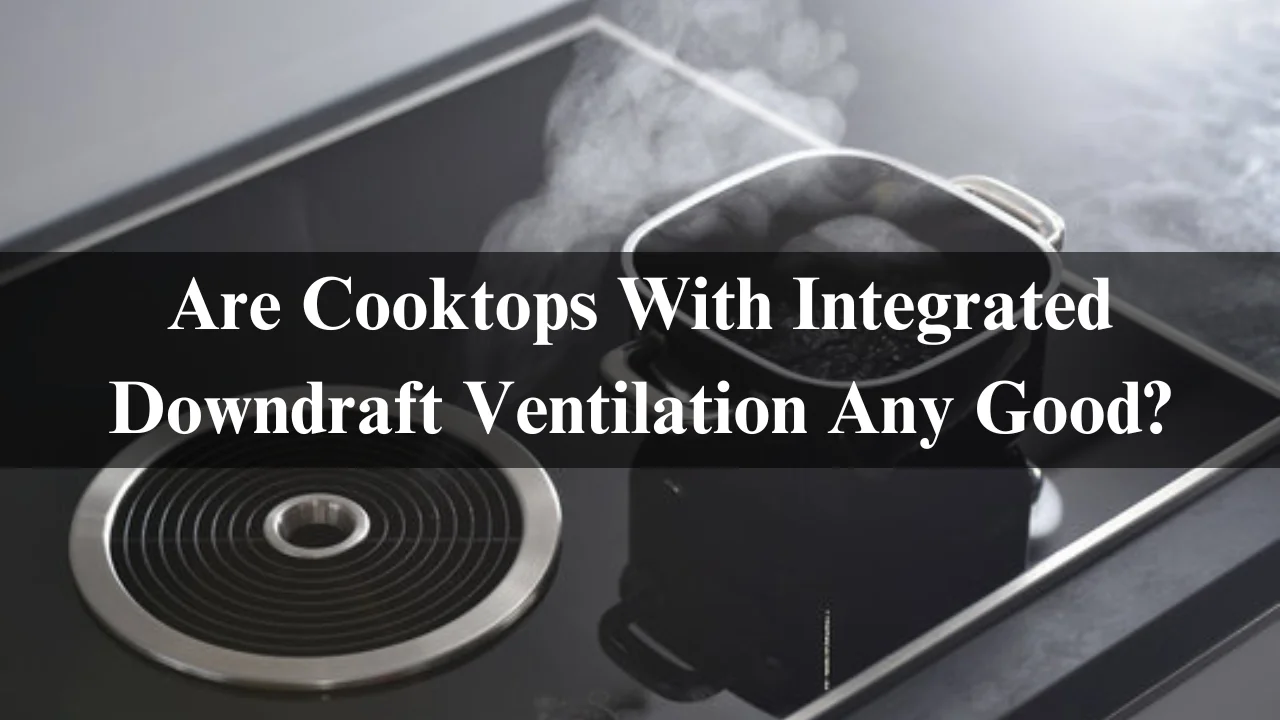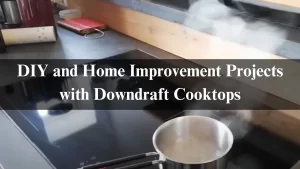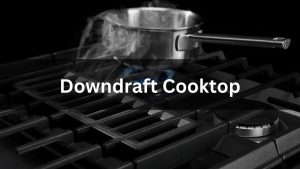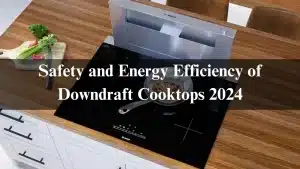Imagine cooking your favourite meal with the enticing aroma wafting through the kitchen. But instead of smoke rising to stain your ceiling or linger in the air, it vanishes discreetly as you prepare. This scenario becomes a reality with integrated downdraft cooktops. These innovative appliances blend style and functionality, making them an appealing option for modern kitchens.
As homeowners seek cleaner aesthetics and efficient ventilation solutions, downdraft systems are gaining traction. They promise to transform how we think about kitchen design and air quality while delivering excellent cooking performance. So, what exactly are these wonders? Let’s dive deeper into the world of integrated downdraft ventilation and discover if they truly live up to the hype.
Table of Contents
What Are Integrated Downdraft Cooktops?
Integrated downdraft cooktops are a modern solution for kitchen ventilation. Unlike traditional setups, these cooktops come with built-in exhaust systems that pull smoke and odours downward directly from the cooking surface.
When you turn on the burner, the downdraft mechanism activates. This sleek design eliminates the need for bulky overhead hoods. Instead of obstructing your view or disrupting your kitchen’s aesthetics, it seamlessly blends into your countertop.
The airflow is managed through strategically placed vents that capture steam and fumes as they rise. Once collected, air travels into ducting hidden beneath the counter or recirculates back into the room after filtration.
This innovative approach enhances functionality and elevates style in contemporary kitchens. It’s all about creating an efficient workspace without compromising on design integrity.
Definition and how they work.
Integrated downdraft cooktops are innovative kitchen appliances that combine cooking surfaces with built-in ventilation systems. Unlike traditional setups, where a hood hangs over the stove, these units incorporate fans directly into the cooktop.
When you turn on your burner, the downdraft system activates simultaneously. It pulls steam, smoke, and odours downward through vents at the cooktop’s back, drawing air away from food as it cooks.
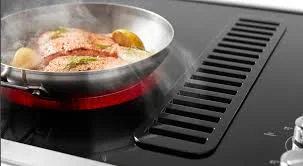
The design is sleek and space-saving. Many models allow the vent to retract or remain hidden beneath the surface when not in use. This feature maintains an uncluttered look in your kitchen while ensuring effective airflow when needed.
Merging cooking and ventilation functions into one unit enhances aesthetics and functionality in modern kitchens.
Differences from traditional overhead ventilation.
Integrated downdraft cooktops differ significantly from traditional overhead ventilation systems. One of the most notable distinctions is their design. While standard vent hoods are mounted above cooking surfaces, downdraft systems blend seamlessly into the cooktop.
This integration allows for a more streamlined kitchen aesthetic. You won’t have to deal with bulky installations that can clutter your space or limit sightlines.
Another difference lies in functionality. Traditional overhead hoods rely on upward airflow to capture smoke and odours, sometimes resulting in uneven extraction. In contrast, downdraft ventilation pulls air directly downwards, efficiently capturing steam and grease at the source.
Noise levels vary, too. Downdrafts often operate quieter than typical range hoods, providing a calmer cooking experience without compromising performance or efficiency.
Cleaning and maintenance tend to be simpler with integrated systems as there’s no need to contend with an extensive ductwork setup found in conventional models.
How Do Downdraft Ventilation Systems Work?
Downdraft ventilation systems pull smoke, steam, and odours from the cooking surface. When you turn on the cooktop or activate the downdraft feature, a fan beneath the cooking area begins to draw air downward.
Airflow enters through strategically placed vents around the cooktop. This design efficiently captures airborne particles right at their source.
Once captured, this air is channelled through ducting that leads either outside your home or into a filtration system for recirculation. Depending on your kitchen’s layout and preferences, you can choose between venting out or recycling.
Unlike traditional overhead hoods that rely on upward airflow, downdrafts take a more direct approach. This unique mechanism minimises heat and smoke buildup while maintaining a discreet look in modern kitchens.
Detailed explanation of the downdraft mechanism.
The downdraft mechanism has a unique approach to capturing smoke, steam, and odours. The integrated system activates automatically when cooking or can be switched on manually.
As heat rises from pots and pans, the downdraft vent pulls it toward the cooktop surface. This is achieved through strategically placed vents located around or under the burners.
Airflow is then directed into an internal fan that creates suction. The fan works quietly yet efficiently to draw air downwards before channelling it through ductwork beneath the kitchen floor or up to an exterior wall.
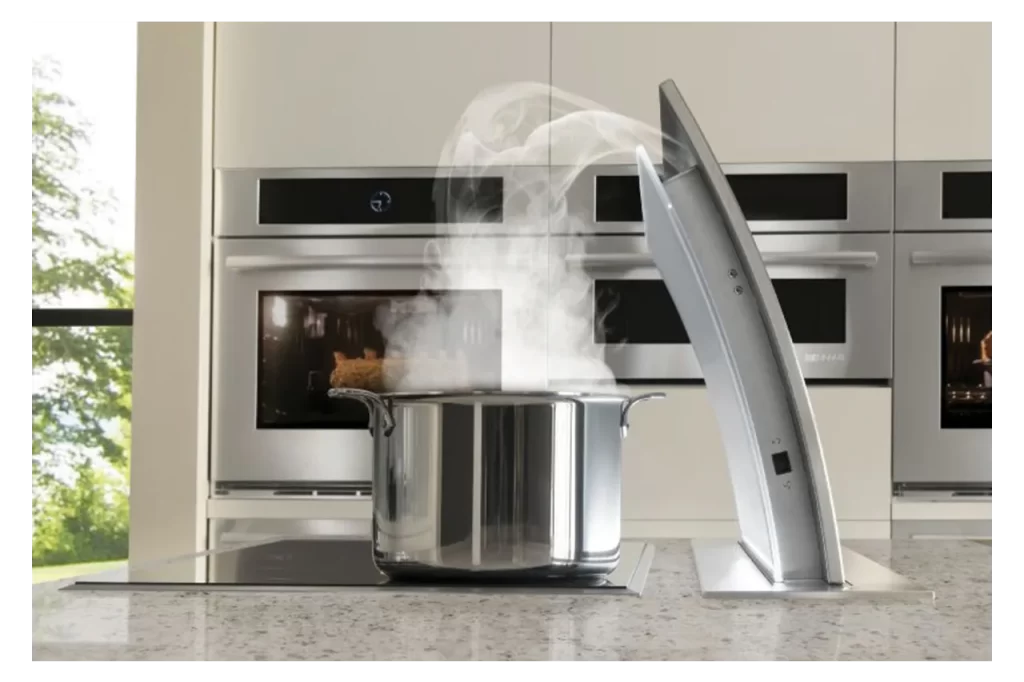
Some designs even allow for adjustable heights of the ventilation system when in use, maximising its effectiveness without obstructing sightlines during meal prep. This clever design ensures clean air circulation while maintaining a sleek aesthetic in modern kitchens.
How airflow is managed: from the cooktop to the ducting system.
Airflow management in downdraft ventilation systems is a precise science. When you cook, heat and grease rise from the surface. The integrated downdraft mechanism captures these emissions directly at the source.
As the air travels down, it passes through strategically placed filters that remove unwanted particles and odours. This ensures cleaner air returns to your kitchen environment.
After filtration, The airflow moves into ducting that channels it outside or recirculates it indoors. This dual approach helps maintain indoor air quality while efficiently venting away cooking byproducts.
Unlike traditional systems that rely on upward suction, this method creates a seamless experience without bulky overhead vents obstructing your view or kitchen design.
How downdraft ventilation differs from traditional vent hoods.
Downdraft ventilation operates differently than traditional vent hoods. Instead of drawing air upward, it pulls smoke and odours from the cooking surface. This subtle shift in airflow can be a game-changer for many kitchens.
While standard hoods often hang overhead, obstructing sightlines, downdraft systems remain flush with the cooktop. They disappear into the counter or stove when not in use, maintaining an uncluttered look.
Moreover, traditional vent hoods typically require more ductwork and ceiling space. Downdraft systems streamline installation by moving directly to a ducting system below countertops.
This design flexibility makes them particularly appealing to those with limited kitchen space or unique layouts where overhead installations may pose challenges. The sleek appearance and effective performance offer a modern alternative to classic vent solutions.
What Are the Benefits of Integrated Downdraft Cooktops?
Integrated downdraft cooktops offer a sleek and modern solution for homeowners looking to enhance their kitchen experience. Here are some benefits of integrated Downdraft Cooktops: Their sleek and modern design enhances kitchen aesthetics.
- Space-saving: Eliminates the need for bulky overhead hoods.
- Effective smoke and odour management: Pulls air downwards to minimise unwanted smells.
- Easy maintenance: Fewer components to clean.
- Installation flexibility: Fits seamlessly into various kitchen layouts.
An overview of the advantages offered by these systems.
Integrated downdraft cooktops bring a fresh perspective to kitchen ventilation. These systems pull smoke, steam, and odours downwards directly from the cooking surface, creating a more streamlined look without bulky overhead hoods taking up space.
One of the major advantages is their aesthetic appeal. An integrated design means maintaining an open feel in your kitchen while effectively managing air quality. They blend seamlessly with modern kitchens where style matters just as much as functionality.
Another benefit is the flexibility they provide in layout. Traditional vent hoods often require specific placements, while downdraft systems allow greater freedom when designing your cooking space. You can position the cooktop wherever it works best for you—whether on an island or against a wall.
These systems are also easier to clean than conventional range hoods, which collect grease and grime over time. The integrated filters in downdraft units can often be removed and cleaned quickly, ensuring that maintenance doesn’t become overwhelming.
Moreover, many integrated downdraft models offer advanced features like adjustable fan speeds and quiet operation modes. This allows users to manage airflow according to their cooking needs without unnecessary noise disruption during meal prep or entertaining guests.
The innovative nature of these cooktops makes them ideal for those who value efficiency and aesthetics in their culinary spaces. Altogether, they present a compelling option for anyone looking to upgrade their kitchen’s ventilation system while keeping style at the forefront.
Do Downdraft Ventilation Cooktops Save Space?
Downdraft ventilation cooktops certainly aim to maximise space, especially in open-concept kitchens. Integrating the vent directly into the cooking surface eliminates the need for bulky overhead hoods that can disrupt sightlines and take up valuable headspace.
This sleek design allows for a more streamlined kitchen aesthetic while maintaining functionality. If your kitchen layout includes an island or a breakfast bar, downdraft systems offer an excellent option without sacrificing style.
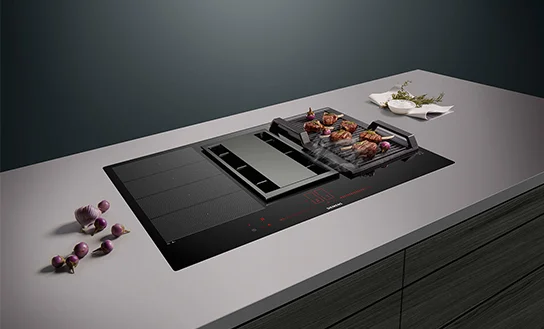
However, it’s important to consider the ducting system involved. While downdraft units can save space above the countertop, their installation might require additional considerations below—especially if you opt for ducted models that lead outside. The balance between aesthetics and practicality is crucial when choosing what fits best in your culinary haven.
Space-saving benefits for open-concept kitchens.
Open-concept kitchens have transformed the way we think about cooking spaces. With more homes embracing this layout, every inch of space matters.
Downdraft ventilation cooktops seamlessly integrate into these designs. They eliminate the need for bulky overhead hoods, which can disrupt sightlines and make kitchens feel cramped.
Opting for downdraft systems creates an airy atmosphere that welcomes interaction during meal prep. Friends and family can gather without feeling obstructed by traditional venting solutions.
Moreover, positioning a cooktop on a kitchen island becomes viable when downdrafts are present. This allows for functionality and social engagement—a perfect blend for modern living spaces where design meets practicality.
Comparison with overhead vent hoods.
Overhead vent hoods have long been the standard for kitchen ventilation. They effectively capture smoke and odours but can take up considerable space, a key concern for many homeowners.
Downdraft ventilation systems offer an alternative that allows for more design flexibility. Instead of a bulky hood hanging over your cooking area, these systems integrate seamlessly into the cooktop.
This integration saves headspace and provides discreet access to your cooking surface. For those who love open-concept layouts, downdrafts maintain sightlines while ensuring proper airflow.
However, it’s worth noting that overhead hoods often provide superior suction power compared to downdraft options. The effectiveness may vary based on cooking styles and preferences; heavier frying or grilling might benefit from traditional setups more than lighter cooking methods.
Is the ducting system more space-consuming than expected?
The ducting system can be a surprising factor when considering downdraft ventilation. Many people assume it will seamlessly fit into their kitchen design without taking up much space. However, that’s not always the case.
The setup often requires a more extensive ductwork installation than anticipated. This typically involves running ducts through cabinets or under floors, which may lead to lost storage opportunities.
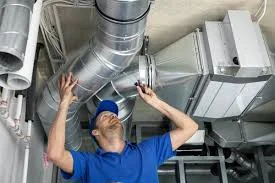
Moreover, depending on your home’s layout, these ducts could compete for valuable real estate in tight spaces. If you’re planning an open-concept kitchen or island cooking area, this might impact how you utilise that space.
Evaluating the benefits and potential challenges of integrating such systems is essential before deciding on your cooking environment. Understanding this aspect can help prioritise functionality alongside aesthetics during your renovation process.
How Does Downdraft Ventilation Impact Kitchen Aesthetics?
Integrated downdraft ventilation systems can dramatically reshape the look of your kitchen. With a sleek design, they eliminate the need for bulky overhead hoods, opening up sightlines and creating an airy atmosphere.
A minimalistic approach is appealing in modern kitchens. Downdraft vents blend seamlessly into countertops or cooktops, ensuring that style doesn’t sacrifice functionality.
These systems enhance flow and visibility between spaces for homeowners aiming for open layouts. No more distracting hoods obstructing views or interrupting decor styles.
Whether cooking on an island or preparing meals in a compact space, downdraft systems keep aesthetics intact while maintaining efficiency. The clean lines contribute to a sophisticated vibe without sacrificing practicality, making them perfect for contemporary homes looking to make a statement.
How integrated downdraft systems affect kitchen design.
Integrated downdraft systems seamlessly blend functionality with style. They eliminate the need for bulky overhead hoods, creating cleaner lines and a more spacious feel in your kitchen.
These systems can be installed on cooktops or ranges, allowing for greater layout flexibility. Whether you prefer an island setup or a traditional wall design, downdraft ventilation adapts to your vision.
Their minimalistic appearance enhances modern aesthetics. With sleek designs available, they complement various styles, from contemporary to industrial chic, without sacrificing performance.
Moreover, integrating these systems opens up possibilities for unique cabinetry solutions. You can create a cohesive look that showcases your taste while maintaining essential airflow and smoke management during cooking sessions.
This versatility makes them particularly appealing for open-concept spaces where visual harmony is key.
The minimalistic appeal of modern kitchens.
Minimalism has become a cornerstone of modern kitchen design. Clean lines and uncluttered spaces create an inviting atmosphere that resonates with simplicity.
Integrated downdraft ventilation aligns perfectly with this trend. By eliminating bulky overhead hoods, these systems contribute to a sleek look. They effortlessly blend into the countertop, allowing for uninterrupted sightlines.
Incorporating such designs makes your kitchen feel larger and more open. The absence of hanging fixtures fosters a sense of airiness that is hard to replicate with traditional setups.
Additionally, minimalistic kitchens often emphasise functionality without sacrificing style. Downdraft systems maintain this balance by providing essential ventilation while enhancing visual appeal.
This approach elevates aesthetics and caters to practical needs in cooking spaces, where form meets function seamlessly.
Use cases for kitchen islands and open layouts.
Kitchen islands serve as multifunctional hubs in open layouts. They enhance the cooking experience while providing additional workspace for meal prep. With integrated downdraft ventilation, you can maximise space efficiency without sacrificing style.
Imagine preparing a family feast while guests gather around the island. The downdraft system discreetly eliminates smoke and odours, maintaining a pleasant atmosphere.
Sightlines are crucial in homes with an open concept. Downdrafts blend seamlessly into your design, offering a clean look compared to bulky overhead hoods. This subtlety allows for greater flexibility in decorating and furniture placement.
Moreover, these systems work well when entertaining. Whether mixing cocktails or flipping pancakes at brunch, you’ll appreciate how they keep the air fresh without interrupting the conversation flow. This makes them particularly appealing in modern designs where form meets function beautifully.
Does Downdraft Ventilation Affect Cooking Performance?
Downdraft ventilation offers a sleek and space-saving solution for kitchens with limited overhead space. While it can add a modern aesthetic to your kitchen, its performance might not be as strong as traditional range hoods, especially when dealing with heavy smoke and odours. A downdraft vent could be a good option if you prioritise space and appearance but are willing to compromise on some ventilation capabilities.
General cooking performance with a downdraft system.
General cooking performance with a downdraft system can vary. While they offer a sleek design and save space, they might not be as efficient as traditional range hoods in removing heat, smoke, and odours. This can lead to slower cooking times and less effective grease removal, especially for heavy cooking like frying or grilling. However, with a high-quality downdraft vent and proper maintenance, you can still achieve satisfactory cooking results, especially in smaller kitchens or for lighter cooking tasks.

Impact on various cooking methods (frying, boiling, grilling)
- Frying: Due to the downdraft vent’s lower heat removal efficiency than traditional hoods, frying can take longer and may result in more smoke and grease buildup.
- Boiling: Boiling is less affected by ventilation, so performance should be similar to using a traditional hood.
- Grilling: Grilling can be challenging with a downdraft vent. The smoke and heat generated may not be effectively removed, leading to potential odour issues and damage to the vent.
Downdraft vents are generally better suited for lighter cooking tasks that don’t produce excessive smoke or heat, such as boiling or simmering. A traditional range hood might be more effective for heavier cooking methods like frying or grilling.
Is Downdraft Ventilation Effective for Heavy Cooking?
No, downdraft ventilation is generally not effective for heavy cooking. While they offer a sleek design and save space, their heat removal efficiency is lower than that of traditional range hoods. This can lead to slower cooking times, excessive smoke and grease buildup, and potential damage to the vent, especially when dealing with heavy cooking methods like frying or grilling.
Downdraft vents are not designed for heavier, more demanding cooking projects like indoor grilling. A traditional range hood is a better choice if you frequently engage in such activities.
Can it handle high-heat and grease-heavy cooking?
No, downdraft ventilation is generally not effective for high-heat and grease-heavy cooking. Although it is designed to remove smoke and odours, its heat removal efficiency is lower than that of traditional range hoods. This can lead to slower cooking times, excessive smoke and grease buildup, and potential damage to the vent, especially when dealing with demanding cooking methods like frying or grilling.
A traditional range hood is a better choice if you frequently engage in such activities.
Challenges in managing steam and smoke from large pots and pans.
While offering a sleek design and space-saving benefits, Downdraft vents can face challenges when dealing with large pots and pans that produce significant amounts of steam and smoke. Here are some key challenges:
- Limited Suction Power: Downdraft vents often have lower suction power than traditional over-the-range hoods. This can make it difficult to efficiently capture and remove large volumes of steam and smoke from large pots and pans.
- Placement Issues: The proximity of large pots and pans to the downdraft vent can also impact its effectiveness. The steam and smoke may not be adequately captured if the vent is too close to the pot or pan.
- Grease Build-up: The high heat and moisture produced by large pots and pans can accelerate grease build-up on the downdraft vent’s filters and internal components. This can reduce its efficiency and require more frequent cleaning.
- Noise: The increased airflow needed to handle large volumes of steam and smoke can lead to higher noise levels from the downdraft vent.
To mitigate these challenges, it is recommended to choose a downdraft vent with powerful suction to ensure proper placement and regular maintenance. Additionally, using lids on large pots and pans can help reduce the amount of steam and smoke released.
What Are the Drawbacks of Cooktops with Integrated Downdraft Ventilation?
Limited Effectiveness with Large Pots: Due to their downward airflow, downdraft extractors may not capture all the fumes and smoke rising from tall pots and pans.
- Limited suction power: Downdraft vents often have lower suction power than traditional over-the-range hoods, making them less effective at removing smoke, odours, and grease.
- Heat interference: The proximity of the downdraft vent to the cooking surface can interfere with heat distribution, leading to uneven cooking or potential damage to the vent.
- Cleaning and maintenance: Downdraft vents require regular cleaning to maintain optimal performance, which can be more challenging than traditional hoods.
- Cost: Cooktops with integrated downdraft ventilation are generally more expensive than those with traditional ventilation systems.
- Limited versatility: Downdraft vents are not as versatile as traditional hoods and may not suit all cooking styles or preferences.
- Less effective for heavy cooking: Downdraft vents are not designed to handle heavy cooking tasks like frying or grilling, as they may not efficiently remove the large amounts of smoke and grease produced.
- Potential for noise: The increased airflow needed to handle steam and smoke can lead to higher noise levels from the downdraft vent.
- Limited effectiveness with large pots and pans: Due to their downward airflow, downdraft vents may not capture all the fumes and smoke rising from tall pots and pans.
While downdraft vents offer a sleek and space-saving design, they may not be the best choice for those who prioritise powerful ventilation or frequently engage in heavy cooking.
Can Downdraft Ventilation Handle Grease and Odors?
Downdraft ventilation can handle grease and odours to some extent, but it may not be as effective as traditional over-the-range hoods. The suction power of downdraft vents is often lower, which can impact their ability to capture and remove grease and odours, especially for heavy cooking like frying or grilling.
While they can still help reduce grease and odours, it is important to choose a high-quality downdraft vent with strong suction and clean the filters regularly to maintain optimal performance.
Effectiveness in managing grease, fumes, and food odours
Downdraft ventilation systems can be effective at managing grease, fumes, and food odours to some extent, but they may not be as efficient as traditional over-the-range hoods. Here’s a breakdown of their effectiveness:
- Grease: Downdraft vents can capture grease, but their effectiveness can vary depending on the suction power and the type of cooking. For heavy cooking like frying or grilling, they may not be as efficient as traditional hoods.
- Fumes: Downdraft vents can help remove fumes, but their ability to capture and expel them can be limited compared to traditional hoods, especially when dealing with large amounts of smoke.
- Food odours: Downdraft vents can help to reduce food odours, but they may not be as effective at eliminating strong odours, especially if the cooking is particularly intense.
To maximise the effectiveness of a downdraft ventilation system, it’s important to choose a high-quality model with strong suction and to clean the filters regularly. Additionally, lids on pots and pans can help reduce the grease, fumes, and odours released.
How downdraft ventilation performs compared to traditional systems.
Downdraft ventilation systems offer a sleek and space-saving alternative to traditional over-the-range hoods. However, they may have some limitations in terms of performance:
- Suction power: Traditional hoods typically have higher suction power, making them more effective at removing smoke, odours, and grease.
- Heat removal: Traditional hoods are better at capturing and expelling heat, which can help to improve cooking performance and reduce the risk of damage to the vent.
- Versatility: Traditional hoods are more versatile and can be used with various cooking styles and techniques.
- Cleaning and maintenance: Traditional hoods can be easier to clean and maintain than downdraft vents.
While downdraft vents can be a good option for those who prioritise space and aesthetics, it’s important to consider their limitations and compare them to the benefits offered by traditional ventilation systems. A traditional hood may be a better choice if you frequently cook heavily or require powerful ventilation.
Installation Complexity of Downdraft Ventilation Systems
The installation process for downdraft ventilation systems can vary in complexity depending on factors like the specific model, your kitchen layout, and whether you’re retrofitting an existing kitchen or building a new one.
Requirements for Installation:
- Ductwork: A downdraft vent typically requires ductwork to connect it to the exterior of your home. The length and complexity of the ductwork will depend on your kitchen layout and local building codes.
- Space: You’ll need enough space in your countertop to accommodate the downdraft vent unit.
- Electrical needs: Downdraft vents require electrical power to operate. You’ll need to ensure that there’s a suitable electrical outlet available in your kitchen.
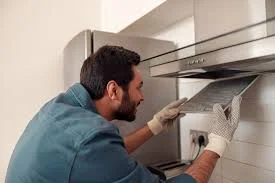
Retrofitting vs. New Builds:
Downdraft vents can be retrofitted into existing kitchens, but installation may be more complex and expensive than installing them in new builds. Factors like the existing countertop layout and electrical wiring can influence the difficulty of retrofitting.
Costs Involved:
The cost of installing a downdraft ventilation system can vary significantly depending on factors like the model you choose, the complexity of the installation, and your location. You can expect to pay several hundred to thousands dollars for the installation.
In addition to the installation costs, you’ll also need to factor in ongoing maintenance costs. Downdraft vents require regular cleaning to maintain optimal performance, including replacing filters and cleaning the internal components.
Overall, while downdraft vents can be installed in both new and existing kitchens, the complexity and cost of installation may vary. It’s recommended to consult with a professional installer to get a more accurate estimate of the costs and to ensure a proper installation.
Energy Efficiency of Downdraft Ventilation vs. Traditional Systems
Downdraft ventilation systems can be more energy-efficient than traditional over-the-range hoods, especially when used correctly. Here’s a comparison:
- Energy Consumption: Downdraft vents consume less energy than traditional hoods, which often have smaller motors and operate at lower speeds.
- Heat Capture: Traditional hoods can capture and recirculate heat back into the kitchen, increasing energy consumption. On the other hand, Downdraft vents typically vent the air directly to the outside, reducing heat loss.
- Ventilation Rate: Downdraft vents often have lower ventilation rates than traditional hoods, which can also contribute to energy savings. However, a lower ventilation rate may also impact their effectiveness in removing smoke, odours, and grease.
Trade-offs Between Performance and Energy Savings:
While downdraft vents can be more energy-efficient, there may be some trade-offs in terms of performance. Lower ventilation rates and reduced suction power can affect their ability to capture and remove smoke, odours, and grease effectively.
A downdraft vent can be a good choice if you prioritise energy efficiency. However, if you require powerful ventilation for heavy cooking or prefer the performance of a traditional hood, you may need to weigh the energy savings against the potential drawbacks.
Ultimately, your best choice will depend on your specific needs and preferences. When deciding, consider factors like your cooking habits, kitchen size, and budget.
Do Downdraft Ventilation Cooktops Make Noise?
Yes, downdraft ventilation cooktops can make noise. The level of noise they produce will depend on factors like the suction power, fan speed, motor quality, and filter condition.
Cooktops equipped with a downdraft vent system may make a humming noise when the vent operates. The vent system causes the humming noise and is part of normal operation. While some models are designed to be quieter than others, it’s important to consider noise levels when choosing a downdraft vent, especially if your kitchen is open-plan or you have a calm living space.
How Long Do Downdraft Ventilation Cooktops Last?
The lifespan of a downdraft ventilation cooktop can vary depending on several factors:
- Quality of materials: Cooktops made with high-quality materials and components are generally more durable and can last longer.
- Maintenance: Regular cleaning and maintenance can help extend the lifespan of a downdraft vent.
- Usage: Frequent and heavy use can accelerate wear and tear, reducing the lifespan.
- Installation: Proper installation is essential for ensuring optimal performance and longevity.
On average, downdraft ventilation cooktops last 5 to 10 years or more. However, with proper care and maintenance, they can potentially last even longer.
Are Downdraft Cooktops Safe to Use?
Yes, downdraft cooktops are generally safe when used properly and maintained regularly. However, it’s important to follow safety guidelines and avoid blocking the vent to prevent accidents.
Moreover, Downdraft cooktops are generally safe when used properly and maintained regularly. However, it’s important to be aware of the following safety concerns and features:
- Fire safety: While downdraft vents can help to reduce the risk of grease fires, it’s still important to use caution when cooking with high heat. Avoid leaving the cooktop unattended, and keep flammable materials away from the cooking surface.
- Vent blockages: Make sure nothing is blocking the vent opening, which can interfere with its performance and pose a fire hazard.
- Common issues: Some common issues with downdraft cooktops include grease buildup, noise, and limited suction power. Regular cleaning and maintenance can help to address these problems.
By following safety guidelines and being aware of potential issues, you can help ensure the safety and enjoyment of your downdraft cooktop.
Are Downdraft Ventilation Cooktops More Expensive Than Traditional Cooktops?
Yes, downdraft ventilation cooktops are generally more expensive than traditional cooktops. This is due to the integrated ventilation system, which adds complexity to the design and manufacturing process. Additionally, downdraft cooktops’ sleek and modern aesthetic often contributes to their higher price point.
Related Articles:
Do downdraft cooking vents work? Latest Update 2024
How Effective Are Downdraft Vents In The Kitchen? 2024
Are Downdraft Extractors More Effective In 2024?
Designing A Kitchen With A Downdraft Cooktop In 2024
Features and Buying Guide Of Downdraft Cooktop Info 2024
Conclusion
Integrated downdraft cooktops offer a modern and sleek solution for kitchen ventilation. Their unique design eliminates the need for bulky overhead hoods, creating a cleaner, more open aesthetic. While they may not be as powerful as traditional range hoods, especially for heavy cooking, downdraft vents can effectively manage grease, odours, and smoke in most situations.
If you prioritise space, style, and ease of cleaning, an integrated downdraft cooktop could be a great choice for your kitchen. However, it’s essential to consider your cooking habits and the specific requirements of your space before making a decision. You can determine if a downdraft ventilation system fits your culinary needs by weighing the pros and cons.
FAQs
Can I install a downdraft cooktop on an island?
Yes, downdraft cooktops are ideal for kitchen islands. They eliminate the need for an overhead hood, keeping your space open and unobstructed.
Are downdraft cooktops more expensive to install?
Yes, they can. The installation often involves custom ductwork, which can increase costs compared to traditional cooktops.
Do downdraft cooktops work well with gas burners?
Yes, some models integrate with gas burners, but performance can be slightly less efficient than with electric cooktops.
Can I replace my existing cooktop with a downdraft cooktop?
Yes, but you’ll need to account for the ductwork. Retrofitting a downdraft system into an existing kitchen can be complex and costly.

